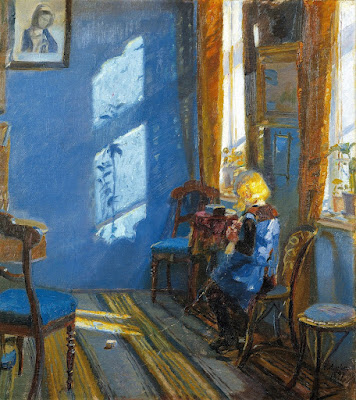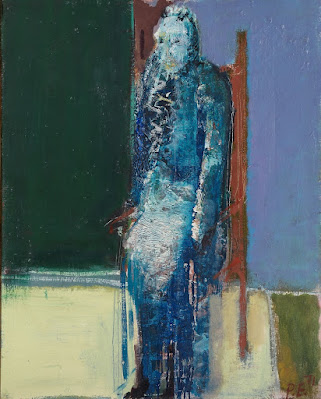 |
| Anna Ancher Sunlight in the Blue Room 1891 oil on canvas Skagens Museum, Denmark |
-1984-acrylic-on-canvas-Dordrechts-Museum.jpg) |
| Erik Andriesse Untitled (Blue Sunflower) 1984 acrylic on canvas Dordrechts Museum |
-Moderna-Museet-Stockholm.jpeg) |
| Oscar Antonsson Nationalmuseum - Midnight Concerts 1937 lithograph (poster) Moderna Museet, Stockholm |
 |
| Karel Appel Titre Bleu 1984 oil on canvas Moderna Museet, Stockholm |
 |
| Joseph Beuys Vitex Agnus ca. 1970 lithograph Moderna Museet, Stockholm |
 |
| Marcel Broodthaers Société 1969-72 paint on vacuum-pressed plastic Moderna Museet, Stockholm |
 |
| Daniel Caffe Mother and Child ca. 1805 pastel on paper Gemäldegalerie Alte Meister, Dresden |
 |
| Marie Louise Ekman Skoaltare 1968 screenprint Moderna Museet, Stockholm |
 |
| Peter Esdaile Blue Guru 1971 oil on canvas Nasjonalmuseet, Oslo |
-Man-in-Blue-Recognition-1983-acrylic-on-canvas-KORO-(Public-Art-Norway)-Oslo.jpg) |
| Johanne Hansen-Krone Man in Blue Recognition 1983 acrylic on canvas KORO (Public Art Norway), Oslo |
 |
| Jean Heiberg Self Portrait in Blue Pullover 1931 oil on canvas Göteborgs Konstmuseum, Sweden |
 |
| Manolis Polymeris Figure in Blue 1951 oil on panel National Gallery, Athens |
 |
| Johs Rian Blue II 1963 oil on canvas Nasjonalmuseet, Oslo |
 |
| Piet Mondrian Composition with Large Blue Plane, Red, Black, Yellow and Gray 1921 oil on canvas Dallas Museum of Art |
-Waiting-c1958-synthetic-resin-paint-on-canvas-G%C3%B6teborgs-Konstmuseum-Sweden.jpg) |
| Lucio Fontana Spatial Concept: Waiting ca. 1958 pigment in synthetic resin on canvas Göteborgs Konstmuseum, Sweden |
 |
| Yves Klein Monochrome Blue - YKB-73 1961 pigment in synthetic resin on cotton, mounted on panel Museum Ludwig, Cologne |
This is the popular version, but the substance of their belief in the river's divinity is this: they believe that human life and existence derive principally from the conjunction of moist and dry elements, and their theory is that all other elements are subordinate to these two and occur only in combination with them; the Nile embodies the moist element; their own land, the dry. This much they disclose to all and sundry, but to initiates they reveal the truth that the land is Isis and the Nile Osiris, with these titles imparting a deeper meaning to the material objects. The goddess longs for her husband when he is away and rejoices at his return, mourns his renewed absence and abominates Typhon like a mortal enemy.* There is, I imagine, a school of natural philosophers and theologians who do not disclose the meanings embedded in these stories to laymen but simply give them preliminary instruction in the form of a myth. But those who have reached the higher grades of the mysteries they initiate into clear knowledge in the privacy of the holy shrine, in the light cast by the blazing torch of truth.
Well, may the gods pardon me for saying this much. The greatest mysteries may not be spoken of: let us respect their sanctity . . .
*Typhon (or Seth), the slayer of Osiris, in this allegory is identified with the desert sun and drought.
– Heliodorus, from The Aethiopica, or, Theagenes and Charikleia (3rd or 4th century AD), translated from Greek by J.R. Morgan (1989)
*Typhon (or Seth), the slayer of Osiris, in this allegory is identified with the desert sun and drought.
– Heliodorus, from The Aethiopica, or, Theagenes and Charikleia (3rd or 4th century AD), translated from Greek by J.R. Morgan (1989)